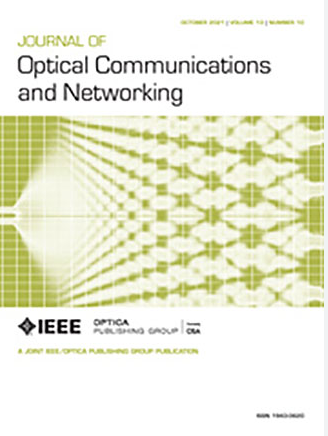用户专用光路切换与光-无线协同控制,实现低延迟和无缝切换
IF 4
2区 计算机科学
Q1 COMPUTER SCIENCE, HARDWARE & ARCHITECTURE
引用次数: 0
摘要
我们提出了一种用户专用光路切换技术,可在全光子网络(APN)的无线接入网(RAN)中实现低延迟和无缝切换。APN 是一种通过为每个用户分配专用波长的光路直接连接端点的网络,可提供大容量和低延迟连接。由于第五代(5G)和第六代(6G)之后的移动系统将要求极低的延迟,因此将 APN 应用于 RAN 有望实现这一目标。然而,由于组成 APN 的光交换机不具备互联网协议 (IP) 层功能,无法在传统路由器网络中实现路由控制以进行切换,因此,采用 APN 的 RAN 在移动系统切换过程中面临光路径切换的挑战。为解决这一难题,我们提出了光路径切换技术,利用光-无线协同控制,结合用户设备(UE)的切换程序,切换专用于执行切换的光路径。该技术的关键在于下一代节点 B(gNB)向光交换机发送最佳时间光路径切换触发器。我们在实验中演示了以 APN 为前提,在 RAN 中为 UE 生成专用光路,从而实现所提出的光路切换技术。为了评估所提出的光路径切换技术的可行性和有效性,我们在实验中比较了光交换机和路由器在切换过程中路径切换的延迟性能、数据包丢失和数据包误导。结果表明,路由器在切换过程中成功地进行了光路径切换,没有出现数据包丢失和数据包误导,同时单个网络设备的延迟时间减少了 99%,从路由器的 4 µs 减少到光交换机的 45 ns。本文章由计算机程序翻译,如有差异,请以英文原文为准。
User-dedicated optical path switching with optical-wireless cooperative control for low-latency and seamless handover
We propose a user-dedicated optical path switching technique for low-latency and seamless handover in the radio access network (RAN) with the all-photonic network (APN). The APN is a network that connects end points directly with optical paths of dedicated wavelengths assigned to each user and provides large-capacity and low-latency connections. As mobile systems beyond 5th generation (5G) and 6th generation (6G) will require extremely low latency, applying the APN to the RAN is promising to achieve this. However, the RAN with the APN has a challenge in optical path switching during the handover procedure of mobile systems because optical switches that compose the APN do not have an Internet protocol (IP) layer function that enables routing control for handover in the conventional router network. Our proposed optical path switching technique to solve this challenge utilizes optical-wireless cooperative control and switches an optical path dedicated to user equipment (UE) executing handover in conjunction with its handover procedure. The key point of the proposed technique is that a next generation node B (gNB) transmits an optimal-timing optical path switching trigger to the optical switch. We experimentally demonstrated the generation of a dedicated optical path for UE in the RAN with the APN as a premise to enable the proposed optical path switching technique. To evaluate the feasibility and effectiveness of the proposed optical path switching technique, we experimentally compared the optical switch and router in terms of latency performance, packet loss, and packet misdirection in the path switching during handover. The results indicated successful optical path switching during handover without packet loss and packet misdirection while reducing the latency per single network equipment by 99%, from 4 µs for the router to 45 ns for the optical switch.
求助全文
通过发布文献求助,成功后即可免费获取论文全文。
去求助
来源期刊
CiteScore
9.40
自引率
16.00%
发文量
104
审稿时长
4 months
期刊介绍:
The scope of the Journal includes advances in the state-of-the-art of optical networking science, technology, and engineering. Both theoretical contributions (including new techniques, concepts, analyses, and economic studies) and practical contributions (including optical networking experiments, prototypes, and new applications) are encouraged. Subareas of interest include the architecture and design of optical networks, optical network survivability and security, software-defined optical networking, elastic optical networks, data and control plane advances, network management related innovation, and optical access networks. Enabling technologies and their applications are suitable topics only if the results are shown to directly impact optical networking beyond simple point-to-point networks.

 求助内容:
求助内容: 应助结果提醒方式:
应助结果提醒方式:


